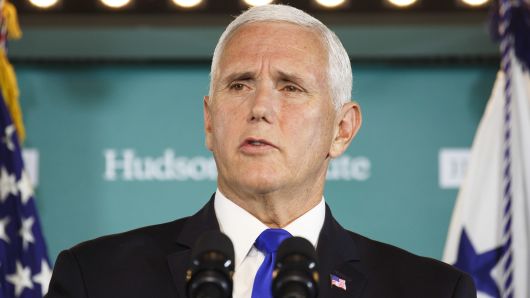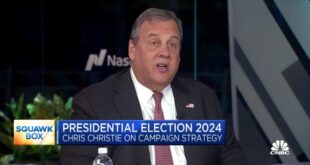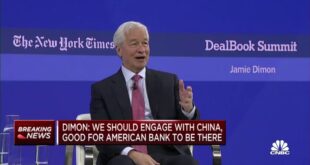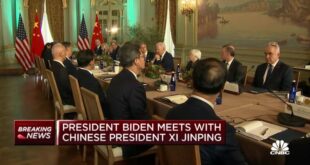
Joshua Roberts | Bloomberg | Getty Images
Vice President Mike Pence speaks at the Hudson Institute in Washington, D.C., U.S., on Thursday, Oct. 4, 2018. Pence laid out allegations of Chinese election interference in a harshly worded speech Thursday, signaling a firmer U.S. pushback against Beijing as trade anxiety weighs on the looming midterm congressional elections.
Even with all news noise focusing on the Brett Kavanaugh Supreme Court confirmation fight and the “not NAFTA” trade agreement among the U.S., Mexico and Canada, it would be a mistake to miss this week’s most significant geopolitical development:
The dramatic unfolding of the Trump administration’s intensified offensive on China.
The administration’s clearest and most comprehensive broadside on China yet followed what one official called “thousands of hours” of study and planning. It will involve agencies across the U.S. government, from the Pentagon to the U.S. Trade Representative. The consequences will be both immediate and potentially generational for global economic and security matters.
Senior officials in Beijing have increasingly worried that President Donald Trump, with his new tariffs on more than $200 billion of Chinese imports, wasn’t just acting as a deal-maker seeking greater leverage for market openings. They suspected a shift was afoot in Washington to more fundamentally address the Chinese challenge.
Now the Chinese have their answer.
What lies behind a series of administration statements and actions was a deepening conviction that Trump’s predecessors have done too little to respond to years of unfair Chinese trade practices, cyber transgressions, rapid military growth, growing technological prowess and the underlying strategic consequences of the so-called Belt and Road economic initiative, whose aggregate investment and loan figures are a multiple of the Marshall Plan.
Four pieces of news this week underscore the far-reaching, multi-faceted nature of the Trump administration efforts aimed at China, with senior officials promising more in the weeks ahead.
They include:
- A landmark speech by Vice President Mike Pence at the Hudson Institute, calling out China as America’s foremost threat, ahead of Russia, due to both the scope and seriousness of its activities abroad and within the United States.
- An underreported aspect of the new U.S.-Mexico-Canada trade agreement that requires all three parties to inform the others if they begin trade talks with “non-market economies” (read China). Trump administration officials view it as a template for trade deals to follow.
- A leaked report that the U.S. Navy’s Pacific Fleet has proposed a series of military operations during a single week in November to send a warning to China and to provide a deterrent to its Beijing’s regional military ambitions.
- On Friday, the Pentagon released the results of a yearlong look at vulnerabilities in America’s manufacturing and military industrial base. “China represents a significant and growing risk to the supply of materials deemed strategic and critical to U.S. national security,” including a “widely used and specialized metals, alloys and other materials, including rare earths and permanent magnets,” the report says.
Pence went far beyond Trump’s UN speech statement that China was acting to influence American elections against him. Pence said for the first time, echoing a view held by Trump since before his presidential campaign, that “what the Russians are doing pales in comparison to what China is doing across this country.”
Pence acknowledged that Trump has built a strong personal relationship with Chinese President Xi Jinping and that they’ve worked together on issues of common interest, particularly the denuclearization of the Korean Peninsula.
But, said Pence, “the American people deserve to know … Beijing is employing a whole-of-government approach, using political, economic and military tools, as well as propaganda, to advance its influence and benefit its interests in the United States. China is also applying this power in more proactive ways than ever before, to exert influence and interfere in the domestic policy and politics of our country.”
Some will argue that the timing of the Trump-China reset has an electoral purpose ahead of U.S. midterms elections. However, the comprehensive approach ensures it will last long beyond November. It also reflects a shift of thinking among American experts regarding China. Most have abandoned the hope that Chinese economic growth would bring with it democratic change, a greater embrace of individual rights and thus greater common cause with the U.S.
 EU News Digest Latest News & Updates
EU News Digest Latest News & Updates



